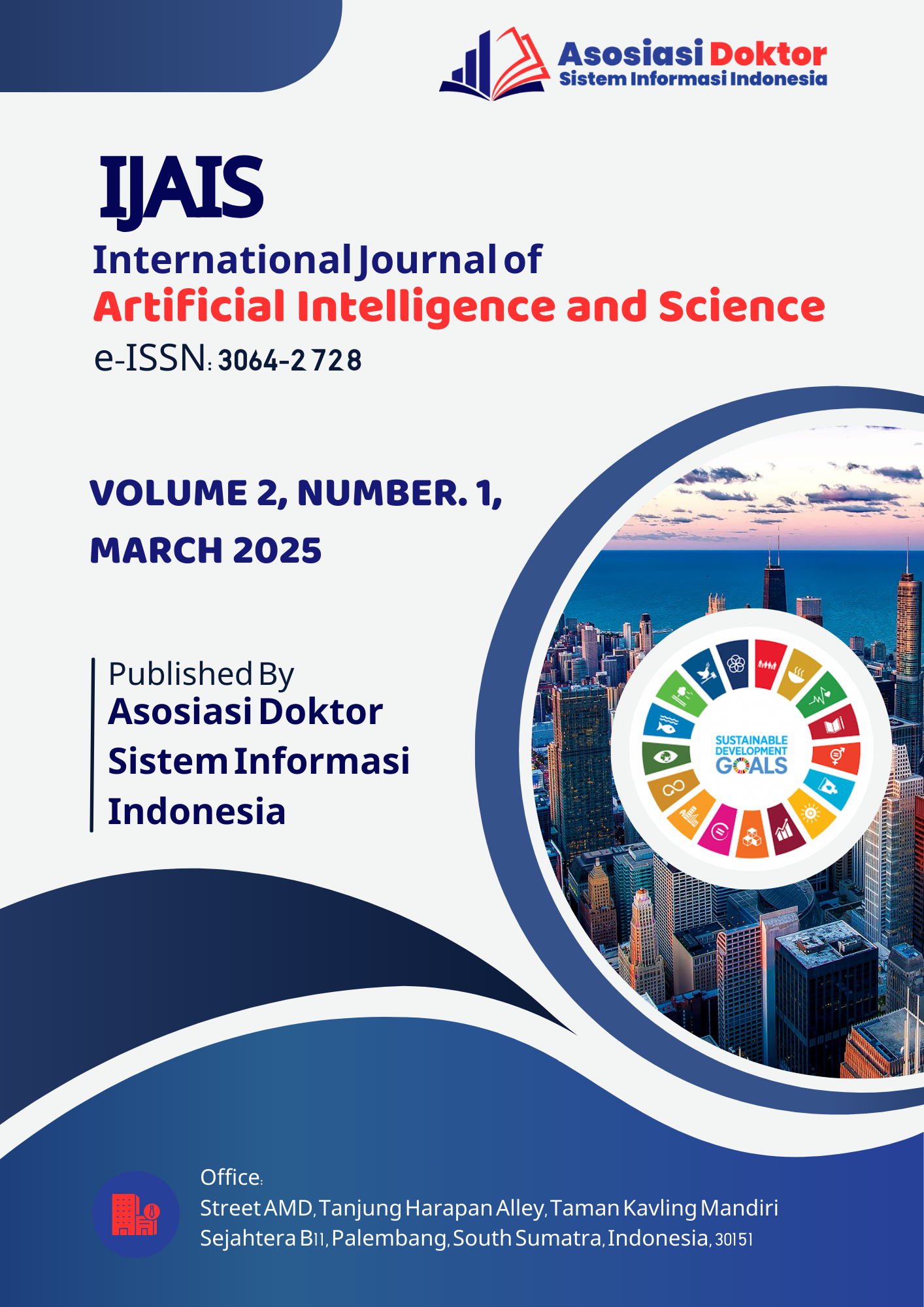Artificial Neural Network for Investigating the Impact of EMF on Ignition of Flammable Vapors in Gas Stations
DOI:
https://doi.org/10.63158/IJAIS.v2.i1.19Keywords:
Artificial Neural Networks, Radio Frequency Radiation, Flammable Vapors, Perceptron, Machine Learning, Hazard Prediction, Safety in Mega StationsAbstract
The inadvertent ignition of flammable vapors by radio frequency (RF) radiation poses a significant safety risk in mega gas stations, necessitating the development of an intelligent predictive model for hazard prevention. This study proposes Artificial Neural Networks (ANN) Model to classify and predict ignition risks based on structured datasets obtained from smart sensing devices. The model formulation is based on the perceptron architecture, incorporating threshold logic units (TLUs) and multi-layer perceptron’s (MLPs) with backpropagation learning for enhanced predictive accuracy. The dataset, preprocessed to remove noise and redundancy, was divided into an 80:20 training-to-testing ratio and evaluated using cross-validation techniques. The experimental results show that the ANN-based model achieved an accuracy of 86%, demonstrating its effectiveness in identifying the impact of hazardous conditions. These findings underscore the robustness of the proposed approach, offering a reliable solution for mitigating ignition hazards in industrial environments. This research contributes to advancing safety protocols by leveraging on machine learning for predictive hazard assessment in flammable vapor-prone areas.
References
I. J. Umoren, D. E. Asuquo, O. Gilean, and M. Esang, "Performability of retransmission of loss packets in wireless sensor networks," Computing. Inf. Sci., vol. 12, no. 2, pp. 71–86, 2019.
V. Garaj-Vrhovac, G. Gajski, and S. Paˇzanin, "Assessment of cytogenetic damage and oxidative stress in personnel occupationally exposed to the pulsed microwave radiation of marine radar equipment," Int. J. Hyg. Environ. Health, vol. 214, no. 1, pp. 59–65, 2011.
H. Koylu, H. Mollaoglu, F. Ozguner, M. Naziroglu, and N. Delibas, "Melatonin modulates 900 MHz microwave-induced lipid peroxidation changes in rat brain," Toxicol. Ind. Health, vol. 22, pp. 211–216, 2006.
H. Lai and N. P. Singh, "Melatonin and a spin-trap compound block radio-frequency electromagnetic radiation-induced DNA strand breaks in rat brain cells," Bioelectromagnetics, vol. 18, no. 6, pp. 446–454, 1997.
J. Schüz, R. Jacobsen, J. H. Olsen, J. D. Boice Jr, J. K. McLaughlin, and C. Johansen, "Cellular telephone use and cancer risk: update of a nationwide Danish cohort," J. Natl. Cancer Inst., vol. 98, no. 23, pp. 1707–1713, 2006.
G. J. Hook, D. R. Spitz, and J. E. Simet, "Evaluation of parameters of oxidative stress after in vitro exposure to FMCW- and CDMA-modulated radiofrequency radiation fields," Radiat. Res., vol. 162, no. 5, pp. 497–504, 2004.
I. Lagroye, G. J. Hook, and B. J. Wettring, "Measurements of alkali-labile DNA damage and protein-DNA cross-links after 2450 MHz microwave and low-dose gamma irradiation in vitro," Radiat. Res., vol. 161, no. 2, pp. 201–214, 2004.
R. A. Tell and R. Kavet, "Electric and magnetic fields < 100 kHz in electric and gasoline-powered vehicles," Radiat. Prot. Dosim., 2016.
World Health Organization (WHO), Environmental Health Criteria Monograph No. 238: Extremely Low Frequency Fields, 2022. Available: http://www.who.int/peh-emf/publications/elf_ehc/en/. [Accessed: 24-Jan-2022].
Y. X. Liu et al., "Exposure to 1950-MHz TD-SCDMA electromagnetic fields affects the apoptosis of astrocytes via caspase-3-dependent pathway," PLoS ONE, vol. 7, no. 4, e42332, 2012.
I. J. Umoren and S. J. Inyang, "Methodical performance modelling of mobile broadband networks with soft computing model," Int. J. Comput. Appl., vol. 975, pp. 8887, 2021.
M. Shahhosseini, G. Hu, and S. V. Archontoulis, "Forecasting corn yield with machine learning ensembles," arXiv preprint arXiv:09055, 2020.
I. Kononenko, "Machine learning for medical diagnosis: History, state of the art and perspective," J. Artif. Intell. Med., vol. 1, pp. 89–109, 2001.
S. W. Choi and H. M. Kwon, "Characteristics of induced voltage in loop structures from high-frequency radiation antenna," J. Korean Soc. Saf., vol. 29, pp. 49–54, 2014.
R. K. Eckhoff and O. Thomassen, "Possible sources of ignition of potential explosive gas atmospheres on offshore process installations," J. Loss Prev. Process Ind., vol. 7, pp. 281–294, 1994.
I. R. Bradby, "Practical experience in radio frequency induced ignition risk assessment for COMAH/DSEAR compliance," ABB Engineering Services, UK. Symp. Ser., no. 154, 2008.
V. Rajkumar and P. Bhattacharjee, "Risk assessment of RF radiation ignition hazard," in Proc. Int. Conf. Rel. Infocom Technol. Optim. (ICRITO), Noida, India, 2015, pp. 1–3.
A. Geron, Hands-on Machine Learning with Scikit-Learn, Keras & TensorFlow, Concepts, Tools and Techniques to Build Intelligent Systems, 2nd ed. Sebastopol, USA: O’Reilly Media, Inc., 2019.
PD CLC/TR 50427:2004, Assessment of inadvertent ignition of flammable atmospheres by radio frequency-radiation – Guide, ISBN 0 580 45883 0, 2006.
I. Umoren, O. Abe, G. Ansa, S. Inyang, and I. Umoh, "A new index for intelligent classification of early syndromic of cardiovascular (CVD) diseases based on electrocardiogram (ECG)," Eur. J. Comput. Sci. Inf. Technol., vol. 11, no. 4, pp. 1–2, 2023.
W. B. Wang, H. L. Jiang, and Y. P. Zhang, "Analysis of radio frequency risks in flammable and explosive environments," Adv. Mater. Res., vol. 1092–1093, pp. 717–721, 2015, Trans Tech Publ.
US-AE (2011) Department of US Army, Ammunition and Explosives Safety Standards, Pamphlet 385–64, USA.
O. Nwankwo, M. Edem, J. Muku, C. Ike, and E. Ogionwo, "Achieving safety at sea–discussing the safety programs implemented by the Nigerian Upstream Petroleum Regulatory Commission," in SPE Nigeria Annual International Conference and Exhibition, Aug. 2022, p. D021S004R002. SPE.
S. Inyang and I. Umoren, "Semantic-Based Natural Language Processing for Classification of Infectious Diseases Based on Ecological Factors," International Journal of Innovative Research in Sciences and Engineering Studies (IJIRSES), vol. 3, no. 7, pp. 11-21, 2023.
A. P. Ekong, A. Etuk, S. Inyang, and M. Ekere-Obong, "Securing against zero-day attacks: A machine learning approach for classification and organizations’ perception of its impact," J. Inf. Syst. Inform., vol. 5, no. 3, pp. 1123–1140, 2023.
I. Umoren, S. J. Inyang, U. E. Etuk, and D. Essien, "A clustering-based artificial intelligence approach for minimizing ionizing radiation exposure in Uyo Metropolis, Nigeria," INNOVATICS: Innovation in Research of Informatics, vol. 7, no. 1, 2025.
Published
Issue
Section
License
Copyright (c) 2025 Imeh Umoren, Saviour Inyang, Ubong Etuk, Aloysius Akpanobong , Gabriel James (Author)

This work is licensed under a Creative Commons Attribution 4.0 International License.





